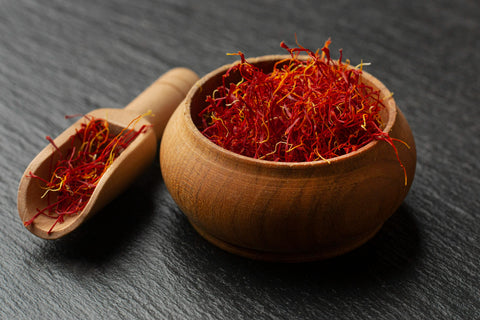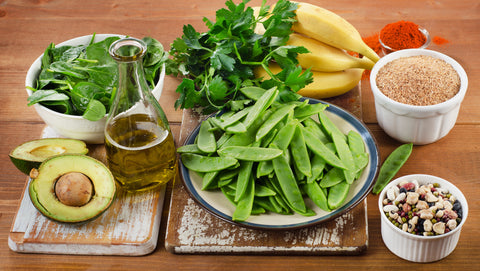What is Saffron?
Saffron is one of the most valuable and expensive spices known worldwide, thanks to its colour, flavour and medicinal properties. It belongs to the family Iridaceae and is derived from the flower of the saffron crocus (Crocus sativus). It is native to Iran, and it was first cultivated in the Persian Empire. Saffron is characterised by a bitter taste and hay like fragrance caused by the presence of two phytochemicals, picrocrocin and safranal (Kamalipour et al., 2011). It is also rich with the antioxidants crocin and crocetin, which are the two most active compounds in saffron. Despite being an antioxidant, crocin acts as an carotenoid dye, which gives food a rich golden-yellow hue.
Medicinally, saffron has a long history as part of traditional healing. Recent modern research has identified anti-carcinogenic (cancer-suppressing), anti-mutagenic (mutation-preventing), immuno-modulating, and antioxidant properties. Many studies have also emerged recently, showing the beneficial effects of saffron in depression, premenstrual syndrome (PMS), and Alzheimer ’s disease.

Pharmacokinetics of crocin and crocetin
In terms of Saffron pharmacokinetics, crocin is hydrolysed to crocetin before absorption through the gastro-intestinal tract and is largely excreted from the intestinal tract following an oral administration. Crocetin on the other hand, is quickly absorbed after oral administration and can be detected in the plasma in free form as well as in the form of a glucuronic acid conjugate. The short plasma half-life of crocetin enables rapid elimination, without being accumulated in the body.
Medicinal Properties of Saffron
Cardiovascular benefits
Antioxidants in saffron tea can reduce the risk of cardiovascular diseases. Crocetin indirectly helps to prevent risk of developing atherosclerosis and heart attack by reducing cholesterol levels in the blood. In 2005, Zheng et al. administered crocetin, the natural carotenoid antioxidant, to rabbits to determine its effect on the development of atherosclerosis. In this study, the scientists randomly assigned rabbits to three different diets for eight weeks: a standard diet, a high lipid diet (HLD), or a high lipid + crocetin diet. The HLD group developed hypercholesterolemia and atherosclerosis, while the
crocetin-supplemented group decreased the negative health effects of a high lipid diet. This study further demonstrated a significant decrease in the aorta cholesterol deposits, atheroma, foam cells, and atherosclerotic lesions in the crocetin-fed group. They suggested that crocetin supresses the nuclear factor kappa B (NF-κB) activation in the aorta, which in turn decreases the vascular cell adhesion molecule-1 (VCAM-1) expression.
Premenstrual syndromes (PMS) benefits
Premenstrual syndromes are among the most common health problems reported by women, affecting around 40 percent of women of reproductive age. Saffron is considered as an excellent antispasmodic with ability to effectively relieve spasm pain. A study done by Hosseini et al. (2008) investigated the effect of saffron on PMS symptoms. Women aged 20—45 years with regular menstrual cycles who experienced PMS symptoms for at least six months were eligible for the study. Women were randomly assigned to either group A, who receive 15 milligrams of capsule saffron twice a day in the morning and evening or group B, who received a capsule placebo twice a day for a two menstrual cycles. To evaluate the results from the study the scientists used Premenstrual Daily Symptoms (PDS) questionnaire and Hamilton Depression Rating Scale (HAM-D). The results from the study demonstrated a significant improvement in both tests (PDS and HAM-D) for the women in the saffron group compared to their pre-treatment symptoms; it also showed a significant improvement in symptoms compared to the placebo group.
Anxiety and Depression benefits
Depression is a serious disorder in today’s society with prevalence as high as 21 percent of the general population in some developed countries. Saffron has been demonstrated as effective anti-depressant in recent studies. In a double-blind, randomised control trial done by Akhondzadeh et al. (2004) participants were randomly assigned to receive a capsule of saffron (30 milligrams a day) or a capsule of a well-known antidepressant, imipramine (100 milligrams per day) for a six-week study. Saffron at this dose was found to be effective in a similar manner to imipramine in the treatment of mild to moderate depression. In another double-blind randomised control trial done by Mazidi et al. (2016), the anti-depressant effect of saffron was evaluated on 60 adult patients with anxiety and depression. The patients were randomised to receive a 50 mg saffron capsule or a placebo twice daily for 12 weeks. Beck Depression Inventory (BDI) and Beck Anxiety Inventory (BAI) questionnaires
were used at baseline, 6 and 12 weeks after initiating medication and the saffron supplements demonstrated a significant effect on the BDI and BAI scores.
Skin benefits
Saffron has been traditionally used to add shine to the skin and reduce dark pigments, dark circles under the eyes, acne and pimples, possibly due to its ability to scavenge free radicals. It is suspected that the antioxidant crocin inhibits active compound of DNA damage, or acts as an activator for DNA excision repair enzymes (Konoshima et al., 1998). In another study done by Zeka et al. (2018), hydrogels enriched with saffron antioxidants were tested on a primary fibroblast cells and showed good biocompatibility with the in vitro cultured fibroblasts. This could indicate effectiveness of saffron in applications such as wound treatment or beautification. Saffron also has an antifungal effect which makes it effective for the treatment of acne, blemishes, and blackheads.
Any information or product suggested on this website is not intended to diagnose, treat, cure or prevent any medical condition. Never disregard medical advice or delay in seeking it because of something you have read on this website. Consult your primary healthcare physician before using any supplements or making any changes to your regime.
Reference:
- Akhondzadeh, S., Fallah-Pour, H. et al. (2004). Comparison of Crocus sativus L. and imipramine in the treatment of mild to moderate depression: A pilot double-blind randomized trial. BMC Complementary and Alternative Medicine. 4(12), 32-41.
- Hosseini, A., Kashani, L. (2008). Crocus sativus L. (saffron) in the treatment of premenstrual syndrome: a double-blind, randomised and placebo-controlled trial. BJOG. 115(4), 515-519.
- Kamalipour, M., Akhondzadeh, S. (2011). Cardiovascular Effects of Saffron: An Evidence-Based Review. Journal of Tehran University Heart Centre. 6(2), 59–61.
- Mazidi, M., Shemshian, M. et al. (2016). A double-blind, randomized and placebo-controlled trial of Saffron (Crocus sativus L.) in the treatment of anxiety and depression. Journal of Complementary Integrative Medicine. 13(2), 195-199.
- Zeka, K., Ruparelia, K.C., Sansone C. et al. (2018). New Hydrogels Enriched with Antioxidants from Saffron Crocus Can Find Applications in Wound Treatment and/or Beautification. Skin Pharmacology and Physiology. 18(31), 95–98.
- Zheng, S., Qian, Z. et al. (2005). Suppression of vascular cell adhesion molecule-1 expression by crocetin contributes to attenuation of atherosclerosis in hypercholesterolemic rabbits. Biochemical Pharmacology. 5(70), 1192–1199.
- Image credits: Image by Freepik




